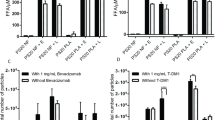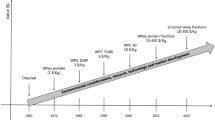Abstract
Purpose. The purpose of the study was to investigate the effect of freeze-thawing processes with different temperature histories on thermal transformations and on protein activity of lactate dehydrogenase (LDH) formulations. Polyethylene glycol (PEG 6000) and maltodextrin were used as cryoprotectants.
Methods. The thermal characterization was made by oscillating DSC (ODSC). LDH activity assays were performed spectrophotometrically.
Results. The crystallization of the solutions and the melting of the frozen samples occurred at fairly constant heat of crystallisation and heat of fusion values and temperatures. The main difference between the two investigated temperature cycles was an exothermic peak at −45°C, which might reflect the transition between the cubic and hexagonal ice structures. When PEG was added to the system an additional endothermic peak appeared at −15°C in the heating program. It was transformed into the shape of a glass transition at the same temperature when the heating rate was increased. The degree of crystallinity of the samples was evaluated as the quota between the cp component of heat of transformation and the total heat of transformation values. Only minor differences between the two temperature histories and between the samples were observed. The cp component of the melting endotherm revealed a complex melting process with two overlapping endothermic transformations. The good protein protecting ability of PEG obtained when cooling and heating rate was low, was greatly reduced with increasing rate. The addition of maltodextrin to PEG-containing solutions lowered the activity recovery.
Conclusions. The endothermic transformation of a PEG-ice structure at −15°C in the heating process is strongly correlated to the protective ability of PEG 6000 in the freeze-thawing process of LDH. To obtain the highest protein activity after the freeze-thawing process, the formulation shall be transformed by a low cooling and heating rate. The crystallinity of the system melting at about 2°C is independent of temperature history. The cp component of the melting endotherm, however, shows a complex transformation, where two phases of different crystallinity and stability might be involved.
Similar content being viewed by others
REFERENCES
J. F. Carpenter, T. Arakawa, and J. H. Crowe. Develop. Biol. Standard. 74:225–239 (1991).
J. F. Carpenter, S. J. Prestrelski, and T. Arakawa. Arch. Biochem. Biophys. 303:456–464 (1993).
V. L. Bronshteyn and P. L. Steponkus. Cryobiology 32:1–22 (1995).
R. W. Michelmore and F. Franks. Cryobiology 19:163–171 (1982).
M. Reading, A. Luget, and R. Wilson. Thermochim. Acta 238:295–307 (1994).
M. Aldén, M. Wulff, and S. Herdinius. Thermochim. Acta 265:89–102 (1995).
S. Corveleyn and J.-P. Remon. Pharm. Res. 13:146–150 (1996).
G. P. Johari, G. Astl, and E. Mayer. J. Chem. Phys. 92:809–810 (1990).
S. Nema and K. E. Avis. J. Parenter. Sc. Technol. 47:76–83 (1993).
Author information
Authors and Affiliations
Corresponding author
Rights and permissions
About this article
Cite this article
Aldén, M., Magnusson, A. Effect of Temperature History on the Freeze-Thawing Process and Activity of LDH Formulations. Pharm Res 14, 426–430 (1997). https://doi.org/10.1023/A:1012083029205
Issue Date:
DOI: https://doi.org/10.1023/A:1012083029205




